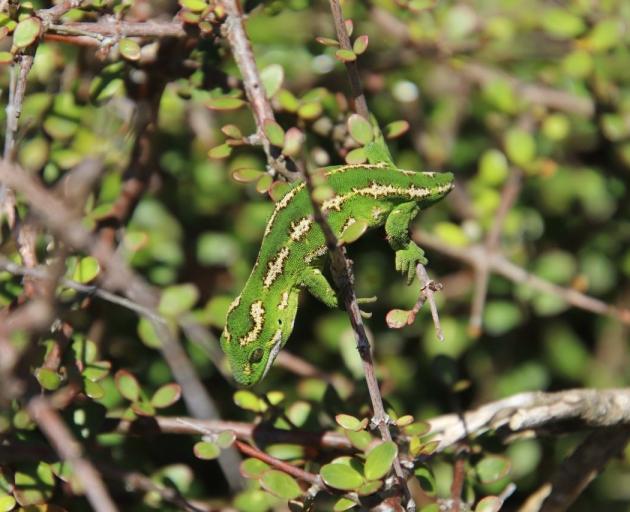
The main component of my research was comparing the movements and behaviour of the enclosure geckos to that of free-roaming jewelled geckos in the wider ecosanctuary, to ensure the enclosure is promoting natural behaviours.

For me, by the fifth day of my fieldwork and a total of 14 hours searching without success for these elusive animals, the leaves and bushes were starting to blur together. I even resorted to pulling up photos on my phone to recalibrate my brain.
It turns out, searching for jewelled geckos in the hot summer heat of February isn’t the best time to start training your eye. It was not until the following June when I had to contain my immense excitement and need to jump up and down - not only had I stumbled upon my first jewelled gecko, in a Coprosma shrub, but it was a perfect, miniature version - a baby jewelled gecko!
Jewelled geckos, known to scientists as Naultinus gemmeus, are one of New Zealand’s nine species of green gecko (Maori: moko-kakariki). Opportunities to view these strikingly coloured lizards, all of which are classified as either Nationally Vulnerable or At Risk and Declining, are limited, especially in naturalistic environments.
Poaching of green geckos has become a key threat (in addition to predation by introduced mammalian predators and extensive habitat modification and removal of dense woody vegetation), and therefore a big concern for wildlife managers throughout New Zealand. The locations of wild green gecko populations are consequently not advertised to the public.
To enable a public opportunity to view our local species, in December 2020 Orokonui Ecosanctuary constructed a captive-breeding and viewing enclosure for jewelled geckos (in between the popular Otago skink and tuatara enclosures).
It is the first open-roofed, naturalistic, green gecko enclosure in New Zealand. The search for young individuals to translocate was not easy, but after six months and about 393 person-hours of effort from volunteers, Orokonui staff and me searching the wider ecosanctuary, the jewelled gecko enclosure welcomed its 10th and final housemate with open arms.
Now there are 10 geckos (juveniles, subadults and young adults) to try to spot in the enclosure. For the security of the geckos, the enclosure is bordered by a low fence with additional security measures in place.

But take some advice from me ... Walk carefully and quietly around and stare at those bushes. You’re looking for even the tiniest variation in the shade of green; most of the time you’ll realise it’s just a gecko-shaped leaf, but practice makes perfect.

In the cooler months, the afternoon is the best time to spot the geckos basking. When it’s cold, the geckos take longer to warm up and get the energy and motivation to expose themselves to the sun - much like us trying to get out of bed on those freezing winter mornings. In the warmer months, early morning is the time to search, before the geckos retreat into the bushes where they can remain warm without exposing themselves.
These geckos are also arboreal, so they can be found at a range of heights. One gecko within the ecosanctuary was spotted about 5m up a manuka tree.
For viewing in the enclosure, bring binoculars if you have them, and make sure you search high and low. And finally, don’t give up - spotting one of these tiny green geckos is well worth it.
- Ellen Richardson is researching the establishment of translocated jewelled geckos 9-11 years after their translocation into Orokonui Ecosanctuary and confirming the suitability of the sanctuary’s jewelled gecko enclosure for her MSc in wildlife management in the Department of Zoology, University of Otago.












